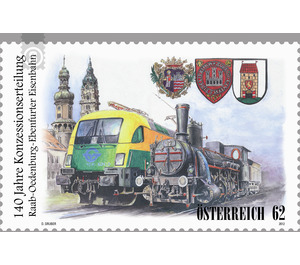140 years - Austria / II. Republic of Austria 2012 - 62 Euro Cent
Theme: Traffic, Transportation & Mobility
| Country | Austria / II. Republic of Austria |
| Issue Date | 2012 |
| Face Value | 62.00 |
| Edition Issued | 812,000 |
| Printing Type | offset |
| Stamp Type | Commemorative |
| Item Type | Stamp |
| Chronological Issue Number | 2368 |
| Chronological Chapter | OOS-OE2 |
| SID | 840300 |
| In 59 Wishlists | |
The Raaberbahn, until 2008 officially "Raab-Oedenburg-Ebenfurter Eisenbahn" (ROeEE), or Hungarian "Györ-Sopron-Ebenfurti Vasút", is a Hungarian-Austrian railway company. Exactly 140 years ago, in 1872, the corresponding concession was granted for a railway line from Raab via Ödenburg to Neufeld on the Leitha, the former state border. The motif of the new special stamp, which is published on this occasion, shows a picture of the 1955 born in Sopron artist Zsolt Kámán, who in turn is employed even in the Raaberbahn. On the right side above you can see the coats of arms of the three naming villages, to the left is the landmark of Sopron, the so-called "fire tower", and the town hall tower of Györ, as well as, in the foreground, a historic and a current locomotive. The former is the steam locomotive No. 17, which was built in 1885 by the locomotive factory Wiener Neustadt and was included as a freight locomotive locomotive in the car park of Raaberbahn. The second is a so-called "Taurus two-frequency locomotive", which from a technical point of view corresponds to an ÖBB 1116 locomotive. History: In 1872, as mentioned above, was awarded a concession for a railway line from Raab to Neufeld on the Leitha, on January 2, 1876 could be opened after delays, the first section to Sopron, followed a short time later, the remaining section. In December 1897 the opening of the Neusiedler Seebahn took place between Parndorf and Celldömölk. Although this was a separate stock company, the ROeEE took over the priority shares and became the owner and operator of this line. After the dissolution of the monarchy, the company remained independent, this did not change even after the Second World War - on the contrary: despite the "Cold War" continued cross-border between Austria and Hungary. From the 1980s, the ROeEE experienced a strong upturn, especially the freight traffic increased, which was not least helped by the freight terminal built in Austria with support from Sopron. In May 1987, the electric operation was started between Györ and Sopron, and a few months later between Sopron and Ebenfurth. For this purpose, the catenary system in Ebenfurth had to be completely rebuilt, as the ÖBB and the ROeEE had used different traction current systems. In 2008, the Austrian company name was changed to "Raaberbahn AG". In 2009, the Hungarian state increased its stake from 61 to 65.6 percent as part of a capital increase.


